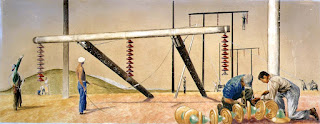Early Modern Art: Great Depression Edition
The Great Depression was a difficult time in American History that impacted the lives of Americans all across the county. The world of art was also impacted, and during this period, artists began to the reflect the lives of the average people and the work that they did. This was made possible by the creation of the Works Progress Administration (WPA), and "through the WPA, artists also participated in government programs in every state and county in the nation" (National Gallery of Art). This led to the art that was created under this program offered "a unique snapshot of the country, it's people, and art practices of the period" (National Gallery of Art). More importantly, "art that was produced by government programs pictured the hardship of the period and the vision for a better America. Breadlines, homelessness, and farms reduced to sand were common subjects" (National Gallery of America) We will take a look at some of the artwork that produced during this era.
Electrification by David Stone Martin, Tennessee River Valley, 1940
In the 1930's, about 9 out 10 farms lacked electricity (The National Archives). In his painting titled Electrification, artist David Stone Martin gives us insight as to how electrical power was brought to a rural areas by the federal government, in places like the Tennessee River Valley (The National Archives). Thanks to the assistance of the Tennessee Valley Authority (TVA), the federal government was able to power the countryside by building huge hydroelectric dams (The National Archives). Martin was able to have this mural placed in a post office in Lenoir, TN (The National Archives). From the view of the observer, we can get a glimpse of what folks in rural areas were dealing with during the Great Depression. We can also see a bit of the success that the New Deal was able to bring to people all across the country by putting people back to work, and through all the other government programs that were created by the New Deal. Martin makes good use of light colors in this art work, which allows people to identify the people involved in the work of establishing the dams, as well as the material and equipment that was used. More importantly, his consists of both vertical and horizonal lines, & as well as curved lines to display the background setting. In addition, we can see a fair use of organic & geometric shapes that Martin uses. However, my reaction to seeing this work of art by David Stone Martin gives me joy and appreciation of what people were going through during that difficult period, and how they were able to overcome the challenges that they faced by working together and by never giving up, no matter the challenges.
Working Girls Going Home by Raphael Soyer, New York, 1937.
Finally, when talking about the era of the Great Depression, one cannot ignore the role or presence of women in everyday life. It's worth noting that during the era of the Great Depression, many men had lost their jobs during this period and as such, women would assist their husbands by picking up jobs in order to help their husbands make ends meet. This painting by Raphael Sover in 1937 that is titled Working Girl Going Home, shows the images of tired women on their way home, with much of their faces hidden (The National Archives). Sover would actually go out to the streets of New York City for inspiration for his work, and would hire models, sometime even the homeless (The National Archives). Critics of Sover's artwork noted that his work consisted of "sad, sentiment quality" that was "highlighted in episodes in the lives of simple, drab human beings (The National Archives). The image of women in this picture with a tired look, somewhat sad, but determined was typical during the Great Depression, where people were striving to do whatever to survive economically and work harder until life returned to normal. The straight and curved lines within this painting are quite visible, the value of Soyer's painting is of low-contrast. The painting has the presence of geometric and organic shapes, and uses only black and white colors. Looking at this painting, I can't help be feel curious and somewhat excited for the women in the painting. They are dressed professionally and elegantly, and the vibes that I get from looking at this painting is that this was a serious time that was affecting so many people, the great depression impacted the lives of so many people.
Works Cited
"Celebrating the People, Part I-A New Deal for the Arts" National Archives. https://www.archives.gov/exhibits/new_deal_for_the_arts/celebrating_the_people1.html. Accessed 13 April 2023
"Uncovering America: Art & the Great Depression" National Gallery of Art. https://www.nga.gov/learn/teachers/lessons-activities/uncovering-america/great-depression.html#:~:text=Artists%20during%20the%20Depression%20portrayed,saw%20the%20world%20around%20them. Accessed 13 April 2023
"Work Pays for America-A New Deal for the Arts" National Archives. https://www.archives.gov/exhibits/new_deal_for_the_arts/work_pays_america.html. Accessed 13 April 2023





Hi Abdurahman, thank you for sharing these pieces with us! Your topic of The Great Depression pairs so well with the art works you chose. I enjoyed reading your discussion on each piece and how they portrayed the working class during such a significant time in American history. My favorite piece from your virtual exhibit is Raphael Soyer’s Working Girls Going Home. This piece caught my attention right away because of the lines and shapes. As you mention in your discussion, when looking closely one can see all the curvatures and elements of shading. Thank you again for sharing!
ReplyDelete